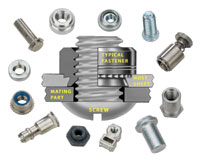
Posted to News on 5th Mar 2013, 00:00
Clinching the case in fastening
The process of considering (or reconsidering) methods to attach thin metal assemblies and/or components can often suggest different and perhaps more practical approaches, says Dr David Quinn of PEM Europe.

>Self-clinching fasteners have particularly enjoyed a long history as ideal solutions for thin metal attachment challenges. They provide permanent and reusable load-bearing threads in sheets too thin to be tapped or where extruded or stamped threads would be impractical.
>Self-clinching fasteners will allow for component removal and re-attachment whenever needed for access or service, often will dramatically reduce the amount of attachment hardware (such as loose washers, lock washers, and nuts), and usually will require only a single mating piece to complete final component attachment. Fewer parts promote lighter designs, quicker assembly, and lower production costs and, when installed, self-clinching fasteners will not loosen or fall out and never have to be handled again.
>The benefits of all self-clinching fasteners essentially stem from their design featuring a unique annular recess for locking the fastener in place and an element to prevent fastener rotation in service. Regardless of type, self-clinching fasteners install permanently in thin ductile metal sheets by pressing them into place in a properly sized hole and applying sufficient squeezing force. This forces a serrated clinching ring, knurl, ribs, or hex head into the panel surface, displacing sheet material into a specially designed annular recess in the shank or pilot of the fastener, known as an undercut. The metal forced into the undercut secures the fastener against axial movement, while a non-round displacer secures the fastener against rotation. No secondary operations are necessary.
>Self-clinching fasteners often take the high road over other conventional attachment methods, whether involving welding, rivets, adhesives or tapes, and for good reasons. While welding would appear to be a natural for joining two sheets of the same type of metal, it is virtually impossible with welding to join dissimilar metals, such as steel to aluminium. If the welded surface is intended to be the finished surface, then additional finishing steps to compensate for burn marks and scale will be required to create a presentable assembly. Some sheets, of course, are just too thin to weld properly.
>Riveting can work more effectively for attaching dissimilar thin materials, but rivets cannot install flush with a finished surface, leaving unsightly metal bulging. Adhesives and tapes fulfill requirements for clean and flush attachments, but their downside is a relative lack of strength and potential fatigue. So there is a strong case for self-clinching fastener technology.
>Self-clinching fasteners can be installed manually in small quantities with a tool as simple as an arbor press. For high-volume jobs, fasteners can be fed automatically using a dedicated installation press or to in-die equipment. Regardless, the sheet material must always meet three basic requirements for success:
>
- Metal sheets into which the fastener will be installed must have adequate ductility to allow the displaced sheet material to cold flow into the undercut without fracturing.
- Metal sheets into which the fastener will be installed must be sufficiently softer than the fastener so that the fastener does not significantly deform.
- Sheets must meet the minimum sheet thickness required by the particular fastener. With trends toward thinner sheets, new product families have been released for sheets as thin as 0.4mm and designs for even thinner sheets are being developed.
>Dozens of types and thousands of variations of self-clinching fasteners have been engineered over the years, including nut products with threads that are free-running, self-locking, floating, or closed end. Self-clinching studs with a variety of head styles are available. Newly introduced 'micro' self-clinching fasteners have expanded application possibilities, offering smaller thread sizes and thinner sheet capability.







